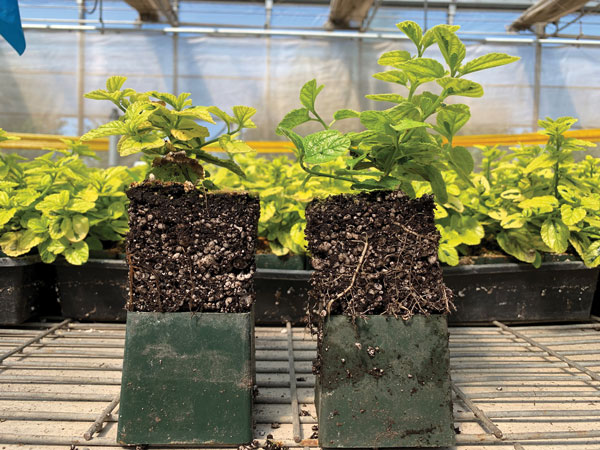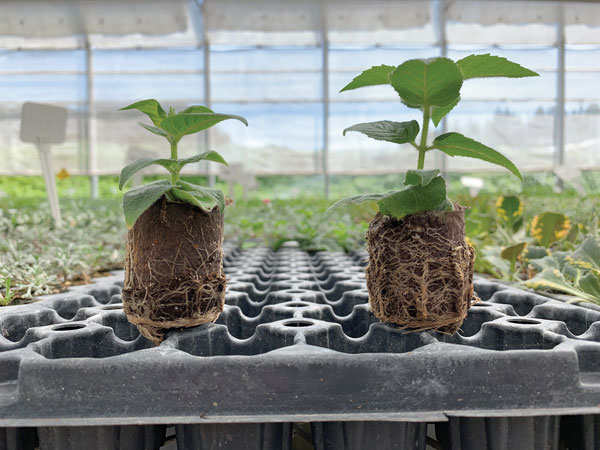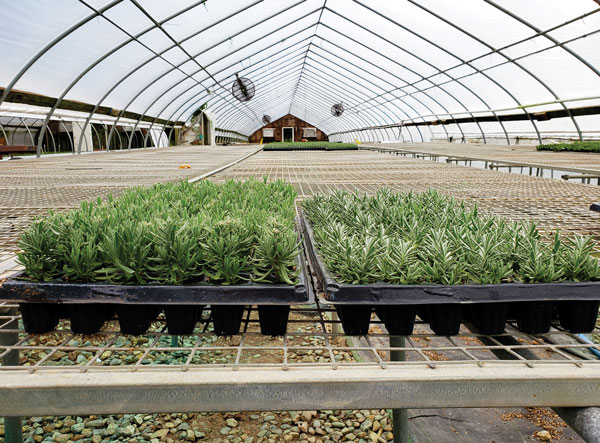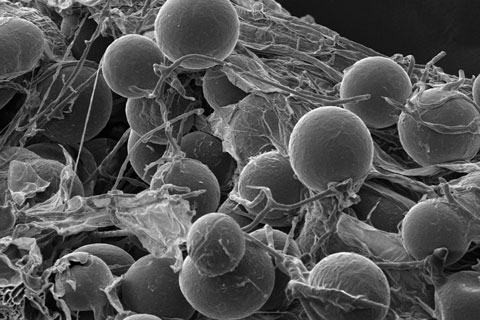1/1/2020
Dynamic Interaction
Bill Calkins

Incorporating mycorrhizal fungi when growing crops from young plants to finished nursery stock is becoming an intriguing subject for growers of all sizes. There’s a rising awareness of the plant performance benefits shown via trials that include only one variable—the incorporation of mycorrhizal fungi—during different stages of plant growth. There are trials in place at many greenhouses and nurseries, as well as educational talks at leading industry trade shows and conferences, and the results are starting to come back positive … very positive.
GrowerTalks spent some time with Blair Busenbark, Sales and Commercial Marketing Manager, and Leonardo Casieri, Global Research Manager, with Mycorrhizal Applications to dig into the science behind mycorrhizal fungi and the results being seen by growers across North America and around the world.
Pictured: Ceanothus thyrsiflorus Diamond Heights nursery trial showing plants treated with mycorrhizal fungi on the right, untreated on the left.
According to Blair, the bottom line is that plants grown with mycorrhizal fungi simply perform better.
“There are benefits for growers and for the downstream users,” he says. “Mycorrhizae give plants in production the opportunity to expand root mass, leading to better uptake of water and nutrients. Then, there are benefits at retail because plants hold up better and have better transplant success for the end consumer.”
It’s this win-win that’s causing professional growers to take notice.
Optimizing production
Since mycorrhizal fungi can be applied at any stage of growing—from initial rooting or transplanting of quick-turn crops like plugs and cuttings through to finishing longer-term crops like perennials and woody ornamentals—it’s interesting to consider the benefits for different types of growers. Blair explains that since it takes about four weeks for the symbiotic relationship between the fungi and plant to kick in, young plant growers might not even see a clear benefit in production, but the grower who transplants that crop into a finished container certainly will.
 “This adds tremendous value to the plug crop,” he adds. And plug growers working with Mycorrhizal Applications are beginning to report shorter production times, better roots and quickness to root liners.
“This adds tremendous value to the plug crop,” he adds. And plug growers working with Mycorrhizal Applications are beginning to report shorter production times, better roots and quickness to root liners.
For perennial and nursery growers incorporating mycorrhizae into production plans, the benefits will be much more evident in the field.
“A crop can be weeks to months shorter when using mycorrhizal fungi,” Blair says. “A perennial grower we work with cut two weeks off of his lavender crop time in production.”
Pictured: Monarda didyma Cranberry Lace nursery trial showing plants treated with mycorrhizal fungi on the right, untreated on the left.
In addition to shorter crop times, improved uniformity has also been seen. The Mycorrhizal Applications team explains a better, stronger root system allows the plant to focus on other things like branching, thicker stems and more blooms.
“The plant has excellent nutrition and responds better to the season,” Leonardo says. “The gains in uniformity are seen at the time and date of harvest with reduced inconsistencies.”
See more scans
In today’s retail environment when plant loss or shrink can be the difference between profit and loss, retail performance is more critical than ever. Blair spent time characterizing the retail benefits that are most intriguing to growers from the largest greenhouses supplying chain stores in a pay-by-scan environment to grower-retailers who also don’t get paid until the product leaves the greenhouse (and doesn’t come back).
From reduced wilt on the retail bench to darker, more visually appealing foliage, plants grown with mycorrhizal fungi have shown increased sell-through.
“These plants are less likely to show signs of nutrient deficiency because the fungi store excess nutrients and then deliver them to the plant’s roots when needed,” he says. “We see fewer plants lost and fewer plants returned. And every plant kept out of the dump pile increases profitability.”
Science says
Leonardo’s team research is aimed at improving products for Mycorrhizal Applications to bring better and better solutions to growers.
“We are characterizing fungi-plant interactions and their benefits to plants to find more and better mycorrhizae for the mix,” he explains. “The key here is that for optimum results, different species of mycorrhizae must be mixed in the product. By including more species in an application, plants have more options to benefit from the variability of different simultaneous symbiotic relationships.”
 Leonardo explains that during different stages like growing and flowering, the plants’ needs are different, but the relationship between a plant and mycorrhizal fungi is always symbiotic. He uses the metaphor of a marketplace.
Leonardo explains that during different stages like growing and flowering, the plants’ needs are different, but the relationship between a plant and mycorrhizal fungi is always symbiotic. He uses the metaphor of a marketplace.
“Plants give carbon in the form of lipids and sugar to the fungi, and the fungi gives nutrients and water to the plant,” he says. Although the balance of this complex exchange isn’t fully known, “plants will give the most ‘money’ to those fungi that gives back the most resources in return.”
Pictured: Lavender greenhouse trial showing plants treated with mycorrhizal fungi on the left, untreated on the right.
There are times during the life of a plant when this symbiotic relationship with mycorrhizal fungi is most important and those times are often the most critical for growers, retailers and consumers. When soil media gets too dry, we all know bad things can happen in a production setting, especially because some types of media dry out much quicker than others.
“Mycorrhizae can help overcome differences in media types,” Blair explains. “The mycorrhizal fungi can store water when it’s available in the soil and help the plant to overcome deficiencies when it is scarce by exchanging it with the plant.”
The soil can dry out, but the plant still has enough water through the interaction with the mycorrhizae. Growers have seen a 36 to 48 hour longer buffer period in production, he says.
Research also has shown seasonal benefits when mycorrhizae are used, reducing the negative impact of different stressors, such as drought, cool weather and hot weather.
“When it gets cool in the fall, untreated plants were more impacted and shut down,” Blair says. “Treated plants weren’t as stressed.”
Cost, ROI and learning curves
Blair says that growers are often surprised how little it actually costs to apply mycorrhizal fungi in production, especially when applied during the plug stage or early on.
“It can cost as little as 5 to 6 cents per plug tray,” he says. “And there’s no need to re-treat.”
There’s a huge benefit for a relatively small input. As the crop gets larger, the cost will go up, but benefits for the grower also increase. He does mention that a standard ROI is tough to characterize because all operations are different. Nonetheless, it’s always an insurance policy, Blair says.
 To maximize the return with the lowest cost, treat as early as possible, he said. “The cost is lowest when the soil volume is low, and every time you bump the crop up, the mycorrhizae stays with it.”
To maximize the return with the lowest cost, treat as early as possible, he said. “The cost is lowest when the soil volume is low, and every time you bump the crop up, the mycorrhizae stays with it.”
Pictured: Mycorrhizal fungi spores as seen through an electron microscope.
Growers can add mycorrhizae to the media in plug trays or apply via a plug dip if buying in young plants. For bareroot perennials, add mycorrhizal fungi to the roots before planting. The product can be used in many ways; the key is simply to get the mycorrhizal inoculant in direct contact with growing roots and there are many ways that this can be accomplished.
In terms of changing processes or learning a new production regime, the curve isn’t steep at all, Leonardo says.
“There are some general things to avoid, such as overfertilizing and applying to the wrong crops (some crops like brassica and mustard are just not mycorrhizal),” he says. “But one of the benefits of mycorrhizae is there are no negative consequences of over-application. There’s low to no risk at all.”
And, when adding mycorrhizae to the production plan, there’s no need to change media. It can be applied as a drench or incorporated into the soil—offering tremendous flexibility for growers. GT